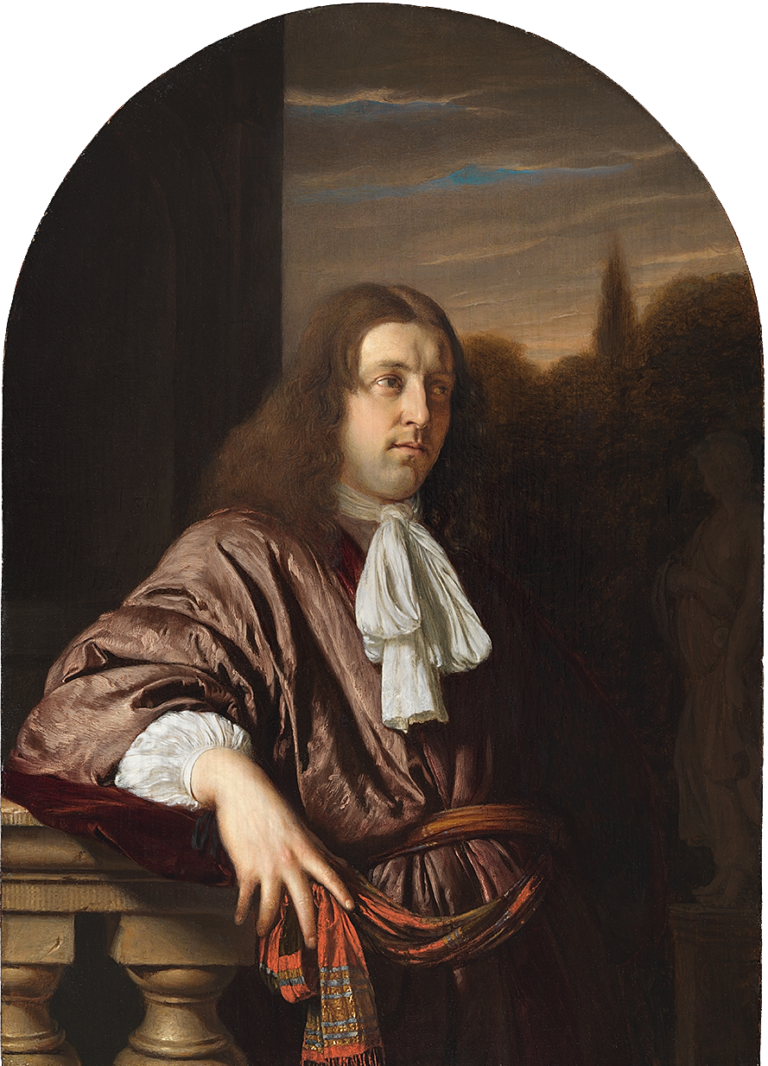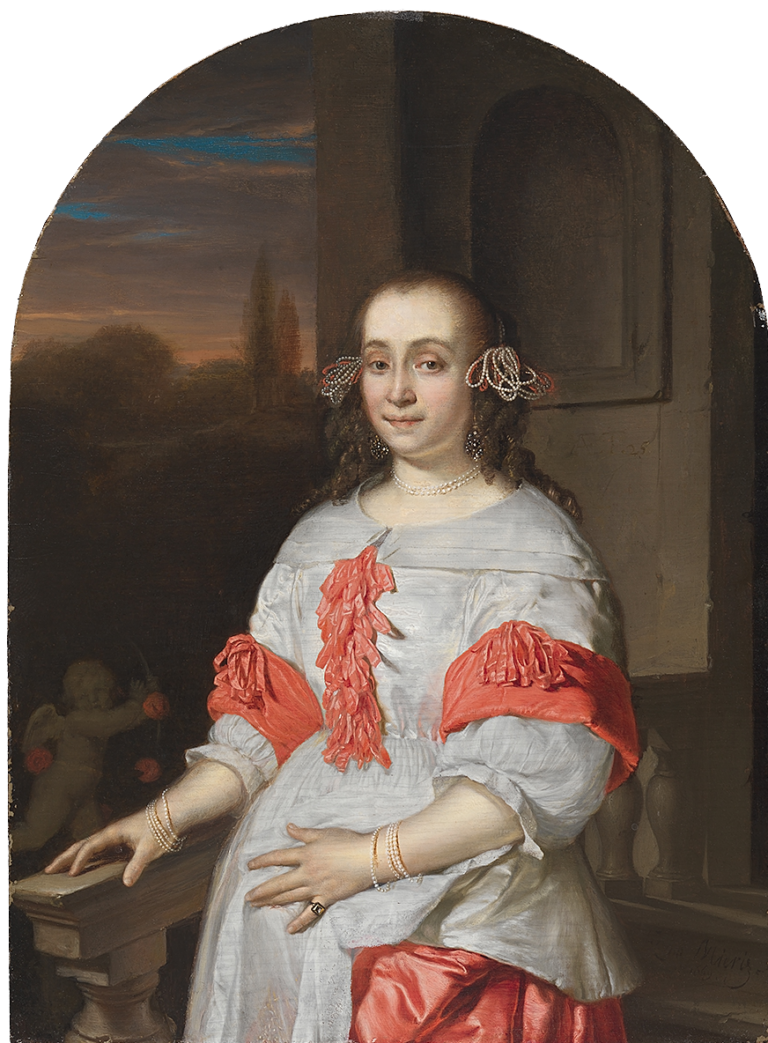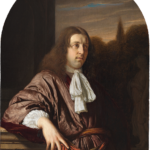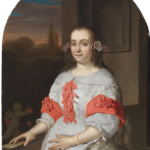In 1669 Cosimo III de’ Medici visited a number of painters in their studios as a part of his “grand tour” through the Northern Netherlands. In his travel journal he referred to three painters as being famous: Rembrandt van Rijn (1606–69), Rembrandt’s pupil Gerrit Dou (1613–75), and Frans van Mieris, “pittore assai celebre.”1 Cosimo visited the latter artist in Leiden on 22 June 1669, the year Van Mieris executed these pendant portraits of an unknown couple, which are among the best portraits to have emerged from that important seventeenth-century artistic center.
Like most of his genre pieces, Van Mieris’s portraits are small and executed in a very refined technique.2 These pendant paintings, which have a long and distinguished provenance but whose whereabouts were unknown for more than half a century,3 are the only pair of his portraits of a husband and his wife that has not been separated over the course of time (see FM-109).4 The two panels show Van Mieris’s great qualities as a portraitist. We see a young couple (according to the inscriptions, “At. 30” and “AET. 25,” the husband was 30 and his wife five years his junior) standing in the open air before a dwelling in a parklike setting. That they belong to the upper classes is evident from their expensive clothing. He is dressed in a fashionable Japonse rok with lace chemise, while she wears a white and red silk dress decorated with red bows. Her hands, neck and hair all are decorated with expensive strands of small pearls, and the large wedding ring on her pinky finger can hardly be missed.
The poses are remarkably lively and interrelated: the man leans on the balustrade in a relaxed manner and gazes at his wife who turns slightly toward him while looking out at the spectator. In the garden behind the man, a sculpture, probably depicting Venus, the goddess of love, is a counterpoint to the sculpture of Cupid with his arrow behind the woman. This juxtaposition of pictorial elements suggests that a loving bond exists between the spouses. She smiles enigmatically, holding her hand on her belly, as if to suggest she is with child.5 Indeed, the gesture can be linked to a Dutch expression of “pushing one’s apron to a side,” meaning to be pregnant.6
The arrangement of these pendants, with the husband placed on his wife’s left, is traditional for such a pairing, an approach from which Van Mieris departed four years later when he painted another set of pendants depicting a married couple (see FM-109). These four panels are the only pendant portraits by Van Mieris that are still extant.7 Despite the different orientation in the two sets, many similarities exist in Van Mieris’s approach. In both sets of paintings, the man gazes at his wife, while she looks at the viewer. They also share a similar contrast between the dress of the male, who wears a comfortable Japonse rok, and that of the female, who is decked out in a satin dress with many ribbons.
Contemporary viewers would have admired the exquisite rendering of virtually every conceivable texture in these paintings, especially the various fabrics of the figures’ clothing. When the French connoisseur and scholar-diplomat Balthasar de Monconys (1611–65) visited Leiden on 13 August 1663, he met “ce fameux Peintre Mirris” (this famous painter Mieris).8 In his travel journal, De Monconys extolled the red velvet cloak of the woman in Van Mieris’s Doctor’s Visit (J. Paul Getty Museum, Los Angeles) and noted that her cream-colored satin dress was executed so well that it looks real: “si bien faits qu’on eust assuré que c’estoit de l’estoffe.”9 In 1675 Joachim von Sandrart (1606–88), describing The Cloth Shop (Gemäldegalerie, Kunsthistorisches Museum, Vienna), the subject of which is germane to this theme, emphasized that the painter had depicted a wide range of fabrics and done so with total conviction.10 In order to render convincingly shimmering fabrics such as satin, Van Mieris applied extremely fine, fluid brushstrokes with infinite patience, to convey folds, gleams of light, or reflections. It is in fact the subtle rendering of the light reflected by the different fabrics that makes them so convincing, almost tactile. The painter’s great eye for detail is also evident from the small chips in the stone balustrade that he depicted with the utmost care.
Only four names of those depicted in Van Mieris’s 20 extant portraits can be identified with some certainty, but these sitters indicate the prominent status of his clientele.11 The earliest identifiable portrait is the striking depiction of Ulrik Frederik Gyldenløve, a Danish count who visited Leiden briefly in 1662.12 The other known sitters are all important Leiden citizens: Agatha Paets, whom Van Mieris portrayed in 1665, was the wife of Cornelis Paets (1636–94), who served several terms as burgomaster of Leiden and was an important client of the artist;13 Florentius Schuyl (1619–69), a Leiden professor whom Van Mieris portrayed in 1666, this time painted on copper;14 and, finally, Franciscus de le Boë Sylvius (1614–72), a professor of chemistry and medicine, and his second wife, Margareta Lucretia Schlezer (see FM-104), who sat for a double portrait by the artist in 1672 (fig 1).15
The names of the sitters in most of Van Mieris’s portraits are unknown because, as is the case here, identifications were often omitted at public sales of family pieces. Buyers were interested more in acquiring a “Van Mieris” than in knowing who was represented, particularly once the paintings left Leiden. The history of Van Mieris’s portrait of Jacob van Heemskerck (1643–64), which the artist probably made in 1663, exemplifies the fate of a number of his portraits. The doors covering that portrait were removed in 1771 when the painting was sold at auction, likely because the doors displayed a family a coat of arms and the sellers did not want this information known.16 Making things more difficult, in the past the provenance of the portrait of Jacob van Heemskerk was confused with that of the male portrait discussed here, in part because both paintings are executed on panels of the same size.17 Whether or not the present pendant paintings once had covering doors is not known, but without identifying coats of arms it is unlikely that the identities of these charming sitters can be determined.18



